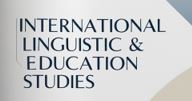- Галузь та проблематика
- Політика розділів
- Політика відкритого доступу
- Архівування
- Types of Articles
- Publication Frequency
Галузь та проблематика
Aims and Scopes
International Linguistic and Educational Studies (ISSN 2313-0482) is a forum to exchange research and knowledge across multiple distinct academic disciplines or fields of study. The ILES is committed to publishing manuscripts via a rapid, impartial, and rigorous review process. Once accepted, manuscripts are granted free online open access immediately upon publication, which permits their users to read, download, copy, distribute, print, search, or link to the full texts, thus facilitating access to a broad readership.
The journal’s scope includes (but not limited to) the following areas of research:
1. Linguistic Studies:
- Phonetics and Phonology: Study of sounds in languages.
- Morphology: Study of the structure of words.
- Syntax: Study of sentence structure.
- Semantics: Study of meaning in language.
- Pragmatics: Study of language in context.
- Sociolinguistics: Study of language and its relation to society.
- Psycholinguistics: Study of the psychological aspects of language.
- Language Acquisition: Study of how people learn languages, both first and additional languages.
- Applied Linguistics: Application of linguistic theories to real-world problems, such as language teaching, translation, etc.
2. Educational Studies:
- Curriculum Development: Design and implementation of educational programs.
- Instructional Methods: Techniques and strategies for effective teaching.
- Assessment and Evaluation: Measuring and evaluating learning outcomes.
- Educational Psychology: Study of how people learn and the best practices in teaching.
- Educational Technology: Use of technology in teaching and learning processes.
- Teacher Education: Preparation and professional development of educators.
- Special Education: Teaching strategies and programs for students with special needs.
- Multicultural Education: Addressing diversity and inclusion in education.
- Language Education: Methods and practices for teaching languages.
3. Intersection of Linguistics and Education:
- Language Pedagogy: The method and practice of teaching languages.
- Bilingual Education: Education in two languages and its challenges.
- Literacy Studies: Development of reading and writing skills.
- Language Policy: Planning and policies related to language use in education.
- Discourse Analysis in Education: Studying communication in educational settings.
- Second Language Acquisition (SLA): How students learn a second language within an educational context.
- Language Testing and Assessment: Development and analysis of language proficiency tests.
Політика розділів
Статті
Політика відкритого доступу
Цей журнал практикує політику негайного відкритого доступу до опублікованого змісту, підтримуючи принципи вільного поширення наукової інформації та глобального обміну знаннями задля загального суспільного прогресу.
Архівування
Цей журнал використовує систему LOCKSS для розподіленого архівного зберігання опублікованого змісту в численних бібліотеках та інформаційних центрах. Бібліотеки - учасниці проекту LOCKSS гарантують довготермінове зберігання вичерпних архівів журналу та автоматичне відновлення пошкодженої інформації. Детальніше...
Types of Articles
International Linguistic and Educational Studies accepts the following types of articles:
- Original research articles are the most common type of a journal article. They are detailed studies reporting new work and are classified as primary literature. Typically, especially in STEM subjects, these articles will include Abstract, Introduction, Methods, Results, Discussion, and Conclusion sections.
- Review articles provide critical and constructive analysis of available published literature in a field. They are usually structured to summarize existing literature, analysis, and comparison. Often, they identify specific gaps or problems and provide recommendations for future research. Unlike original research articles, review articles are considered as secondary literature. It means they generally do not present new data from the author’s experimental work, but instead provide analysis or interpretation of a body of primary research on a specific topic. Secondary literature is an integral part of the academic ecosystem because it can help explain new or different positions and ideas about primary research, identify gaps in research around a topic, or spot important trends that one individual research article may not.
- A case report is a detailed report of the symptoms, signs, diagnosis, treatment, and follow-up of an specific Case reports, which typically describe an unusual or original occurrence, continue to be one of the pillars of medical progress and provide many fresh perspectives on medicine. Some papers contain a thorough analysis of the relevant literature on the subject. A case report is a brief, quick exchange of information between busy clinicians who may not have time or resources to conduct large scale research.
- Research notes are not full academic papers but discussion notes seeking to advance a new idea, theoretical perspective, research program, or methodological approach in scientific studies. When writing a research note, it is important that the author(s) are clear on what kind of contribution they want to make to the field of studies, capable of advancing an intelligible and solid argument in favour of a particular theory, research, or methodology, and that they bring in a novel view to the attention of the journal’s readers. Manuscripts in this category should be concise but definitive.
- A scientific essay is an article whereby you have to analyze a scientific issue or problem and then develop a solution based on factual information and perhaps provide some of your own ideas.
- Scientific commentaries are written by well-known researchers, eminent scientists, or professors. Scientific commentaries can refer to research methodologies, science policy, institutional behaviour or the dealings of early-career researchers. Young researchers can also write scientific commentaries outlining the challenges, issues, and obstacles they encounter in their careers. Young research can also write scientific commentaries as narrations of their senior professors, eminent scientists, and well-known researchers.
Publication Frequency
International Linguistic and Educational Studies publishes quarterly (April, July, October, and December).
 INTERNATIONAL LINGUISTIC & EDUCATION STUDIES
INTERNATIONAL LINGUISTIC & EDUCATION STUDIES